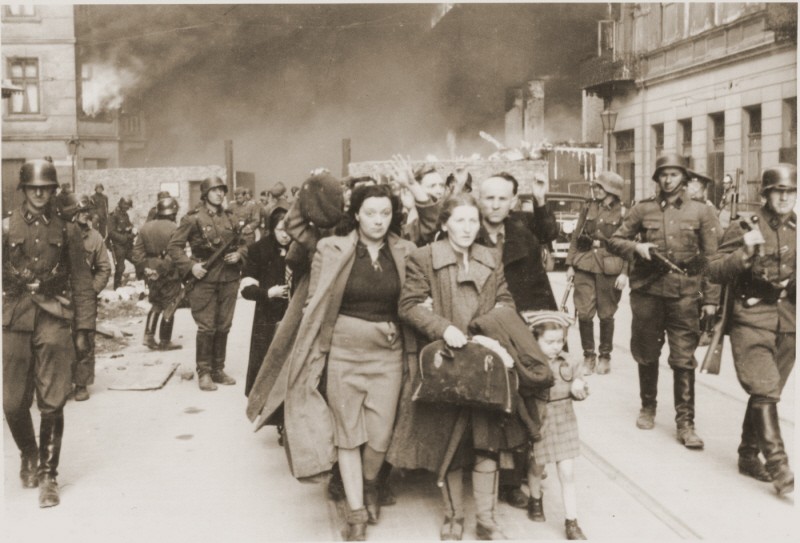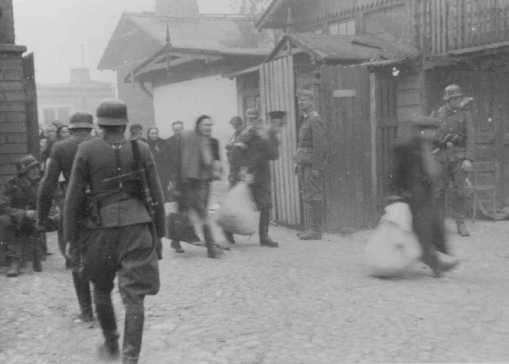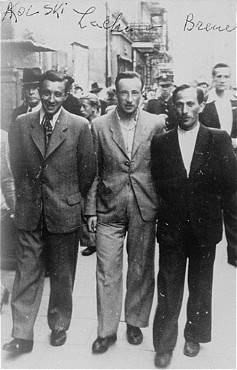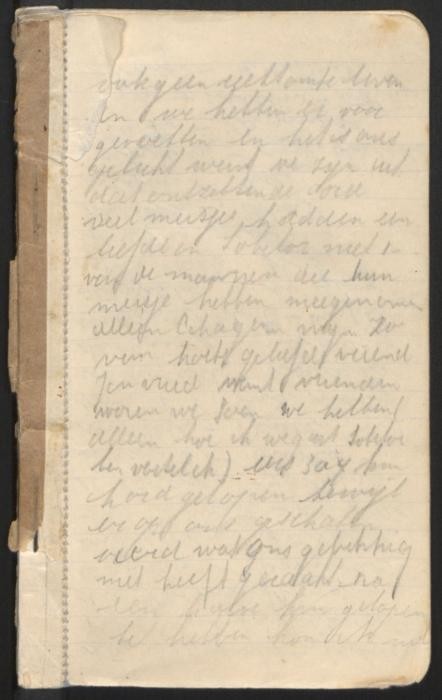
1943: Key Dates
January 5
The SS Inspectorate of Concentration Camps establishes the Herzogenbusch concentration camp in Vught, the Netherlands. The SS will establish a transit camp (Vught) inside Herzogenbusch on January 16 and a women's concentration camp on June 12, 1943.
January 18-22
SS and police units deport approximately 6,500 Jews from the Warsaw ghetto to the Treblinka killing center, and shoot another nearly 1,400 Jews in the ghetto. Members of the Jewish Fighting Organization (Zydowska Organizacja Bojowa; ZOB) resist the actions of the SS and police with armed force.
February
On December 16, 1942, Reichsführer-SS Heinrich Himmler issued a decree for the deportation of all Roma (Gypsies) living in the Greater German Reich to a special family compound in Auschwitz-Birkenau. Under this decree, the German police authorities deport nearly 18,000 Roma to Auschwitz in February 1943.
February 5-12
German SS and police officials and their auxiliaries begin liquidating the Bialystok ghetto. They kill approximately 1,000 Jews and deport 10,000 Jews to the Treblinka killing center, where most are immediately killed.
February 6-15
In Greece, German authorities order Greek Jews in Salonika to move into a ghetto, also requiring them to wear the yellow star and adhere to a curfew.
February 16
The Inspectorate of Concentration Camps formally redesignates the prisoner-of-war camp of the Waffen-SS in Lublin as Lublin concentration camp (also known as Majdanek). During its existence both as a prisoner-of-war camp and as a concentration camp, from October 1941 to July 1944, between 80,000 and 110,000 prisoners die at Lublin/Majdanek. At least 75% of those who die at Lublin/Majdanek are Jews.
February 26
The first large transport of Roma (Gypsies) deported from the so-called Greater German Reich arrives at Auschwitz. German authorities open the Gypsy family camp BIIe at Auschwitz-Birkenau.
March 3-March 22
Bulgarian occupation authorities deport 11,343 Jews from Bulgarian-occupied Thrace, Macedonia, and Pirot to German custody. After taking custody of the Jews, the German authorities will deport them to the Treblinka 2 killing center. Almost none of them survive.
March 15
German SS, police, and military units begin the deportation of Jews from Salonika, Greece, to Auschwitz. Between March 20 and August 18, approximately 46,000 Greek Jews arrive at the Auschwitz camp complex. SS functionaries kill most of the deportees in the gas chambers at Birkenau. During the occupation of Greece, the German authorities deport and kill between 59,000 and 65,000 Greek Jews.
March 15
The SS Inspectorate of Concentration Camps opens the Riga-Kaiserwald concentration camp, near Riga, Latvia.
March 22
From March 3-March 22, Bulgarian occupation authorities deport 11,343 Jews from Bulgarian-occupied Thrace, Macedonia, and Pirot to German custody. After taking custody of the Jews, the German authorities will deport them to the Treblinka 2 killing center. Almost none of them survive.
April 4
King Boris of Bulgaria informs German diplomatic representatives that he will not deport the Jews of Sofia into German custody.
April 7
The SS shuts down the Chelmno killing center. SS Special Detachment Lange eliminates the evidence of the killings there and abandons the site four days later.

April 19-May 16
In the Warsaw ghetto uprising, Jewish fighters resist the German attempt to liquidate the ghetto. German SS and police units shoot approximately 7,000 Jews during the suppression of the uprising and deport another 7,000 of those who survive the armed revolt to Treblinka. The Operation Reinhard deportation coordination office will send approximately 42,000 surviving Warsaw ghetto residents to Lublin/Majdanek concentration camp (18,000) and to forced-labor camps for Jews at Trawniki, Poniatowa, Budzyn, Krasnik, and other locations in Lublin District in the Generalgouvernement. Some resistance fighters escape from the ghetto and join partisan groups in the forests around Warsaw. The Warsaw ghetto uprising is the first armed revolt of civilians in German-occupied Europe.
April 30
German authorities establish a “residence camp” at Bergen-Belsen for Jews suitable for prisoner exchanges with the western Allies. This camp is on a portion of an already existing prisoner-of-war camp. The SS Inspectorate of Concentration Camps later designates the “residence camp” as a concentration camp, where over 36,000 prisoners, most of them Jews, eventually die.
June
By the end of spring 1943, German SS and police and military units have killed at least 1,340,000 Jews and an undetermined number of partisans, Roma (Gypsies), and officials of the Soviet state and the Soviet Communist Party.
June 21
Reichsführer-SS (SS chief) Heinrich Himmler orders the liquidation of all ghettos of the Reichskommissariat Ostland (the Baltic States and Belorussia) and transfer of the remaining Jewish inhabitants who are able to work to concentration camps.
June 23
SS chief Heinrich Himmler orders the liquidation of remaining ghettos in the Generalgouvernement and removal of the Jews capable of work to forced-labor camps and those incapable of work to killing centers in German-occupied Poland.

August 2
Jewish prisoners revolt at the Treblinka killing center. Although around 200 prisoners escape, the members of the SS Special Detachment Treblinka, with support from locally stationed German Gendarmerie and military units, capture and kill most of those who attempted to escape. SS authorities supervise a small detachment of prisoners as they dismantle the camp and remove all remaining traces of its existence. After the killing center is dismantled in November 1943, Special Detachment Treblinka personnel shoot the members of this Jewish labor detachment.
August 6-September
German authorities deport about 8,000 Vilna (Wilno; Vilnius) Jews to camps in Estonia.
August 15-28
After initial agreement to deport Jews from the Romanian provinces, Wallachia and Moldavia, the government of Marshall Ion Antonescu backs away from the agreement and refuses to deport Jews from Romania to the custody of the Germans.
August 16
German SS and police units and their auxiliaries begin the final liquidation of the Bialystok ghetto. By August 21, German authorities have deported the remaining 40,000 Jews from the ghetto to killing centers or forced-labor camps in the Generalgouvernement.
September 8
Italy, Germany's Axis partner, surrenders unconditionally to the Allies. German military and police units quickly occupy northern Italy.
September 15
The SS Inspectorate of Concentration Camps opens the concentration camp Vaivara near Reval, Estonia.
September 23
SS authorities order the final deportation of Jews from the Vilna (Vilne) ghetto (located in Wilno; Vilnius). SS and police units in Wilno (Vilnius) deport about 4,000 Jews to the Sobibor killing center, and transport others to Kaiserwald and Vaivara concentration camps, as well as other forced-labor camps in German-occupied Estonia and to the Kaiserwald concentration camp near Riga, Latvia. Approximately 3,000 Jews remain in forced-labor camps in or near Wilno (Vilnius).
September 20-October
Approximately 7,200 Danish Jews escape to Sweden with the help of the Danish resistance movement and many individual Danish citizens.
October
In his capacity as Higher SS and Police Leader in Trieste, Italy, to which he was appointed in September 1943, SS General Odilo Globocnik authorizes the establishment of the police transit camp and detention camp La Risiera di San Sabba in Trieste. Both both gas vans and crematoria are at the disposal of the camp authorities. At San Sabba, the SS and their auxiliaries kill approximately 3,000-5,000 people, mostly so-called “partisans” but also Jews. The camp serves mainly as a transit camp to incarcerate Jews from Trieste, northeastern Italy, and the Adriatic Coast, before deportation by the SS to Auschwitz and other concentration camps. It also functions frequently as a killing site.

October 14
Jewish prisoners at the Sobibor killing center begin an armed revolt. About 300 escape. SS functionaries and police units, with assistance from German military units, recapture about 100 and kill them. After the revolt, SS Special Detachment Sobibor supervises the dismantling of the camp.
October 15-18
German occupation authorities seize and deport 1,007 Jews in Rome and its environs. Between September 1943 and 1945, German authorities kill approximately 7,800 Italian Jews. Virtually all Italian Holocaust victims died in Auschwitz-Birkenau.
October 21-23
German authorities kill the remaining 3,000-6,000 Jews of the Minsk ghetto in mobile gas vans and in shooting operations at the Maly Trostinets killing site.
October 26
German authorities deport around 2,700 Jews from Kovno (Kaunas) to the labor camps Vaivara and Klooga, in Estonia, and to Auschwitz.
November 1
The SS Inspectorate of the Concentration Camps converts the Kovno (Kaunas; Kovne) ghetto into a concentration camp (Kauen).
November 2
German authorities liquidate the Riga ghetto and shoot the remaining residents, at least 2,000 in number.
November 3
SS and police units implement Aktion Erntefest (Operation Harvest Festival), the murder of the Jewish laborers in concentration camp Lublin/Majdanek and the forced-labor camps Trawniki and Poniatowa. During Aktion Erntefest, SS and police units kill at least 42,000 Jews at Majdanek, Trawniki, and Poniatowa.
December 2
The Inspectorate of Concentration Camps redesignates the Buna subcamp of Auschwitz I as Concentration Camp Auschwitz III, or Monowitz.
Critical Thinking Questions
- How did the Jews attempt to survive and maintain their community integrity and identity as conditions in the ghetto deteriorated?
- How do German actions against the Jews in 1943 illustrate the systematic and bureaucratic nature of the assault on the Jews of Europe?

